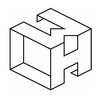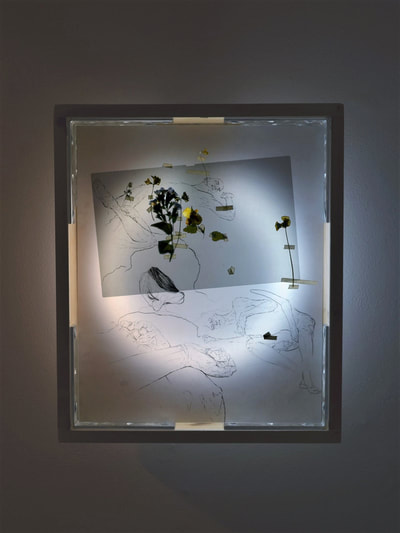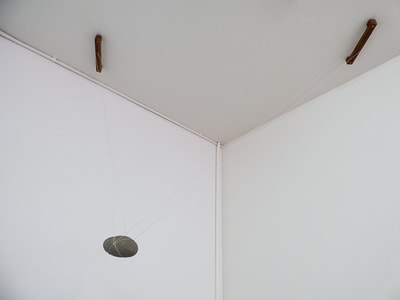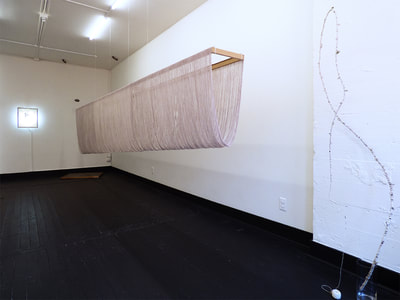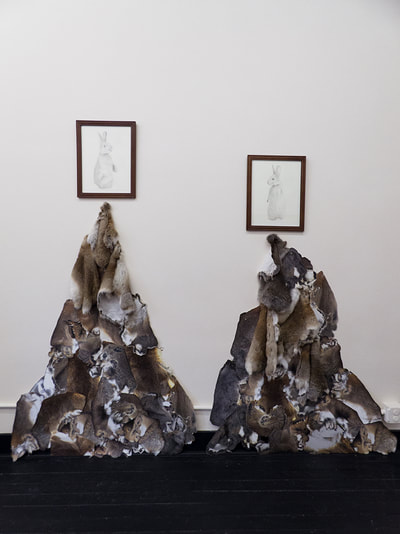BETWEEN REALITY AND THE CONSTRUCTED WORLD
Sequoia Day O'Connell
July 2018
The veil between worlds is defined by Celtic tradition as the boundary between our material world and the spirit world. The belief in Celtic tradition is that the the veil thins with Samhain, at the end of harvest, and the beginning of winter. Our exhibition, The Veil, overlaps with the beginning of the harvest season, when we reap the benefits of our growth and contemplate the losses of the year. As seasons rapidly shift towards autumn, this tender contemplative exhibition is an offering to the shadow self, and the shadow world.
To honor these worlds, the artists included in The Veil have created distinctly unique and poignant languages with their work which speaks to this thin barrier. Their language is meant to evoke a sense of the in-between: the membrane between reality and the constructed world, where life and death exist simultaneously, precariously entwined. In this collection of works in mixed media, installation, and sculpture, artists embody ideas of birth and abundance; of what has been germinating in the spring and summer months that commence the harvest. The emergence is key: the moment when bitter turns sweet turns rotten, and the grief that follows.
These interconnected meanings are touched, spoken, and felt through artwork, but rarely are they concretely addressed. As products of dominant American culture, disconnected from these primordial ideas about origins and endings, we are are both afraid of and obsessed with death; almost as much as we are of sex and of life. And how can we talk about death, sex, and life without becoming trite, or mundane? How does the quietly destructive but tender act of wrapping a blackberry bramble encompass a multitude of narratives around the history of colonization, violence, desire, tension, and regrowth? When we see light hitting a pebble, suspended impossibly in midair, are we allowed to question the rules of physics as they apply to our own bodies and minds?
Taylor Hanigosky’s calculated and tender work reminds us to celebrate tension. Each individual piece is quietly powerful and reactive to its environment, containing a physical curiosity that is full of both childhood wonder and wisdom. She creates a relationship between her collected materials and the room around them, where the negative space itself holds the weight of suspended objects. Her work alludes to both ritual and science—offerings which contain dually ancient and timeless materials (minerals) with distinct reverence of their capacity to represent history and geological time. Each work is like a breath held in tight, the potential for great energy.
Taylor Hanigosky’s “x” aligned with Markel Uriu’s Choked & Swaddled, and Old World (O. Coniculus Dominion & Decline) illustrate the constructed habitat. Hanigosky’s work toys with physics, animating materials which hold a record of life, but which have never themselves lived it. Uriu’s work delicately examines the metaphorical relationship between human colonization and the natural world. In Choked and Swaddled, Uriu tends to the branches of an invasive species, the Himalayan blackberry, by tightly and lovingly wrapping it in string. This is an act of suffocating affection that leads to the plant’s eventual demise. The Himalayan blackberry was brought to this country by Luther Burbank, whose methods of propagating plants were developed in tandem with Eugenicist ideas of population control. Uriu’s work is a complex map of how the expansive history and acts of colonization and human control leave a deep and lasting imprint on the environment. It provokes the question: in which natural world do I live? The violently constructed world, or the imaginary untouched world?
Ko Kirk Yamahira touches on the continuum of life and death. Rather than presenting one end (life) or the other (death), Yamahira starts from the middle. Yamahira’s work subverts both categories of “painting” and “sculpture” by existing in simultaneous states of entropy and wholeness. His process is essential to the work. He starts by painting a stretched canvas, then spends hours delicately deconstructing the painting string-by-string. Through this act, Yamahira becomes the midpoint himself--the catalyst for two ends of the lifecycle of his work. Where Hanigosky’s focus is the middle point, the tension; Yamahira presents us with the roundness of the continuum. The resulting pieces are simple in color and silhouette, but contain hours of fastidious and exacting work. Yamhahira’s installations are nowhere near static as they move and shift with each pull of the canvas, and when displayed, each movement of the viewer.
Where Yamahira’s Untitled (rose) is the middle point, Supine, by Charlie Crowell invites you into the light. Supine, like most of Crowell’s work, shape-shifts. As an illuminated piece, Supine invites you to examine a figure in soft but synthetic light box, in which plants are suspended and held captive for observation. Turned off, Supine is a figure in repose--a resting space for the viewer. As defined by the Merriam-Webster Dictionary, the word “supine” can indicate “1. lying on the back or with the face upward…[or]...2. exhibiting indolent or apathetic inertia or passivity; especially : mentally or morally slack.” Although Crowell’s work is anything but lacking inertia, perhaps Supine is here to offer a breath to the viewer--the permission to rest. Crowell’s piece is both the terminus and first breath of The Veil.
You needn’t hold your breath in this space. The Veil is an offering to you, in the midst of the chaos and grief in our current world. This offering is intended to allow for you to soften your own boundaries around the shadow self and the shadow world. Here, allow your breath to move, if only slightly, the suspended canvas of Yamahira’s work, to contemplate your own natural and unnatural control with Uriu’s Swaddled & Choked, to take in the synthetic warmth of Crowell’s Supine, to be held by your own negative space along with Hanigosky’s Untitled, to allow for the complexities of your own world to exist simultaneously.
To honor these worlds, the artists included in The Veil have created distinctly unique and poignant languages with their work which speaks to this thin barrier. Their language is meant to evoke a sense of the in-between: the membrane between reality and the constructed world, where life and death exist simultaneously, precariously entwined. In this collection of works in mixed media, installation, and sculpture, artists embody ideas of birth and abundance; of what has been germinating in the spring and summer months that commence the harvest. The emergence is key: the moment when bitter turns sweet turns rotten, and the grief that follows.
These interconnected meanings are touched, spoken, and felt through artwork, but rarely are they concretely addressed. As products of dominant American culture, disconnected from these primordial ideas about origins and endings, we are are both afraid of and obsessed with death; almost as much as we are of sex and of life. And how can we talk about death, sex, and life without becoming trite, or mundane? How does the quietly destructive but tender act of wrapping a blackberry bramble encompass a multitude of narratives around the history of colonization, violence, desire, tension, and regrowth? When we see light hitting a pebble, suspended impossibly in midair, are we allowed to question the rules of physics as they apply to our own bodies and minds?
Taylor Hanigosky’s calculated and tender work reminds us to celebrate tension. Each individual piece is quietly powerful and reactive to its environment, containing a physical curiosity that is full of both childhood wonder and wisdom. She creates a relationship between her collected materials and the room around them, where the negative space itself holds the weight of suspended objects. Her work alludes to both ritual and science—offerings which contain dually ancient and timeless materials (minerals) with distinct reverence of their capacity to represent history and geological time. Each work is like a breath held in tight, the potential for great energy.
Taylor Hanigosky’s “x” aligned with Markel Uriu’s Choked & Swaddled, and Old World (O. Coniculus Dominion & Decline) illustrate the constructed habitat. Hanigosky’s work toys with physics, animating materials which hold a record of life, but which have never themselves lived it. Uriu’s work delicately examines the metaphorical relationship between human colonization and the natural world. In Choked and Swaddled, Uriu tends to the branches of an invasive species, the Himalayan blackberry, by tightly and lovingly wrapping it in string. This is an act of suffocating affection that leads to the plant’s eventual demise. The Himalayan blackberry was brought to this country by Luther Burbank, whose methods of propagating plants were developed in tandem with Eugenicist ideas of population control. Uriu’s work is a complex map of how the expansive history and acts of colonization and human control leave a deep and lasting imprint on the environment. It provokes the question: in which natural world do I live? The violently constructed world, or the imaginary untouched world?
Ko Kirk Yamahira touches on the continuum of life and death. Rather than presenting one end (life) or the other (death), Yamahira starts from the middle. Yamahira’s work subverts both categories of “painting” and “sculpture” by existing in simultaneous states of entropy and wholeness. His process is essential to the work. He starts by painting a stretched canvas, then spends hours delicately deconstructing the painting string-by-string. Through this act, Yamahira becomes the midpoint himself--the catalyst for two ends of the lifecycle of his work. Where Hanigosky’s focus is the middle point, the tension; Yamahira presents us with the roundness of the continuum. The resulting pieces are simple in color and silhouette, but contain hours of fastidious and exacting work. Yamhahira’s installations are nowhere near static as they move and shift with each pull of the canvas, and when displayed, each movement of the viewer.
Where Yamahira’s Untitled (rose) is the middle point, Supine, by Charlie Crowell invites you into the light. Supine, like most of Crowell’s work, shape-shifts. As an illuminated piece, Supine invites you to examine a figure in soft but synthetic light box, in which plants are suspended and held captive for observation. Turned off, Supine is a figure in repose--a resting space for the viewer. As defined by the Merriam-Webster Dictionary, the word “supine” can indicate “1. lying on the back or with the face upward…[or]...2. exhibiting indolent or apathetic inertia or passivity; especially : mentally or morally slack.” Although Crowell’s work is anything but lacking inertia, perhaps Supine is here to offer a breath to the viewer--the permission to rest. Crowell’s piece is both the terminus and first breath of The Veil.
You needn’t hold your breath in this space. The Veil is an offering to you, in the midst of the chaos and grief in our current world. This offering is intended to allow for you to soften your own boundaries around the shadow self and the shadow world. Here, allow your breath to move, if only slightly, the suspended canvas of Yamahira’s work, to contemplate your own natural and unnatural control with Uriu’s Swaddled & Choked, to take in the synthetic warmth of Crowell’s Supine, to be held by your own negative space along with Hanigosky’s Untitled, to allow for the complexities of your own world to exist simultaneously.
Sequoia Day O’Connell is a Seattle curator and photographer, as well as a birth and abortion doula. They received a BA in Visual Arts and Psychology from Hampshire College in 2015, and was an organizer with Lions Main Art Collective in 2016-2017, as well as an organizer and member of the Board of Directors at The Vera Project, 2008-2013. Sequoia curated and organized the Blue Lady shows in Northampton, MA, an inclusive art and performance show that highlighted voices in the queer community, using artwork as a foundational element to build and strengthen community relationships. Intimacy is a common thread in their personal, curatorial, and professional work—their photography touches the personal and vulnerable boundaries between body and space, while their work as a birth doula offers support to pregnant people and their families during a pivotal and vulnerable moment.
Brooklyn-based Charlie Crowell is a largely self-taught artist who has dedicated their work to exploring the toxic love affair between past and present. Their work is most inspired by the natural world, sleep, and end of life care. Working across media, their work takes shape through the collective emotional schema that attempt to cope with time’s passage, and how these processes articulate themselves through the body.
Seattle-based artist Taylor Hanigosky carries rocks in her pockets and thinks about time. Her interdisciplinary practice encompasses installation, illustration, photography, writing, and book arts. Currently, she constructs durational installations in which found rocks are suspended by a network of string, tension and their own weight. This work is a meditation on balance, interaction, fragility, and the relationship between human and nature. She has most recently shown at Mount Analogue, BASE Experimental Arts Center, and The Vestibule in Seattle.
Markel Uriu is a Seattle-based interdisciplinary artist. Her work explores impermanence, maintenance, growth, and decay. Drawing from narrative, ritual, and her Japanese-American heritage, she explores these concepts through ephemeral botanical narratives and two-dimensional work. She received her BA from Whitman College in 2011 and has shown nationally, most recently at SPRING/BREAK Art Show in New York City. She is the recipient of the 2016 Artbridge Fellow at Pratt Fine Arts Center, and is a member of Lion's Main Art Collective for Queer and Trans Artists and SOIL Gallery, Seattle.
Born in Los Angeles and raised in Tokyo and London, Ko Kirk Yamahira moved to Seattle from New York in 2015. His practice involves the painstaking removal of individual threads from the weave of the canvas to deconstruct his paintings, converting surface into form. The result is a sculptural wall hanging that reveals the armature of the original painting, while creating softer, elegantly draping forms. He has exhibited in galleries across the United States and Japan, is a member of the artist collectives Art Beasties and SOIL; and was most recently featured in a solo exhibition at the Frye Art Museum in 2018.
Brooklyn-based Charlie Crowell is a largely self-taught artist who has dedicated their work to exploring the toxic love affair between past and present. Their work is most inspired by the natural world, sleep, and end of life care. Working across media, their work takes shape through the collective emotional schema that attempt to cope with time’s passage, and how these processes articulate themselves through the body.
Seattle-based artist Taylor Hanigosky carries rocks in her pockets and thinks about time. Her interdisciplinary practice encompasses installation, illustration, photography, writing, and book arts. Currently, she constructs durational installations in which found rocks are suspended by a network of string, tension and their own weight. This work is a meditation on balance, interaction, fragility, and the relationship between human and nature. She has most recently shown at Mount Analogue, BASE Experimental Arts Center, and The Vestibule in Seattle.
Markel Uriu is a Seattle-based interdisciplinary artist. Her work explores impermanence, maintenance, growth, and decay. Drawing from narrative, ritual, and her Japanese-American heritage, she explores these concepts through ephemeral botanical narratives and two-dimensional work. She received her BA from Whitman College in 2011 and has shown nationally, most recently at SPRING/BREAK Art Show in New York City. She is the recipient of the 2016 Artbridge Fellow at Pratt Fine Arts Center, and is a member of Lion's Main Art Collective for Queer and Trans Artists and SOIL Gallery, Seattle.
Born in Los Angeles and raised in Tokyo and London, Ko Kirk Yamahira moved to Seattle from New York in 2015. His practice involves the painstaking removal of individual threads from the weave of the canvas to deconstruct his paintings, converting surface into form. The result is a sculptural wall hanging that reveals the armature of the original painting, while creating softer, elegantly draping forms. He has exhibited in galleries across the United States and Japan, is a member of the artist collectives Art Beasties and SOIL; and was most recently featured in a solo exhibition at the Frye Art Museum in 2018.
